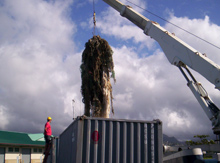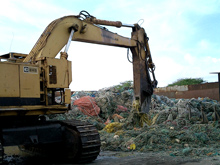Trash to Energy: Hawaii's Marine Debris Recycling

Large piles of derelict fishing net removed from the reefs and shorelines of the Northwestern Hawaiian Islands are brought back to Honolulu Harbor and off-loaded into bins for transport to the facility of Schnitzer Steel Hawaii Corp. Photo courtesy of UH Sea Grant.
Marine debris of all types accumulates in and around the islands of Hawaii due to their location in the middle of the north Pacific Subtropical Gyre. Much of the debris is made up of derelict fishing nets. Large conglomerations of these nets, sometimes weighing thousands of pounds, are removed from Hawaii’s reefs and shores each year. Instead of adding these nets to already congested landfills, Hawaii’s multi-organizational marine debris group devised a unique program to recycle this marine debris into usable electricity.
The nets are transported to the facility of Schnitzer Steel Hawaii Corporation, a mainland-based scrap metal recycler. There, the nets are chopped into small pieces suitable for incineration at the City and County of Honolulu’s H-Power waste-to-energy facility, which is run by Covanta Energy. Schnitzer Steel Hawaii Corporation transports the chopped net pieces to the H-Power facility. There the nets are burned, producing steam which drives a turbine that creates usable electricity. All services (transport included) are donated free of charge.

Heavy equipment is needed to chop the nets into small pieces suitable for incineration at the Honolulu H-Power facility. Equipment and staff time are donated by Schnitzer Steel Hawaii Corp. Photo courtesy of the Schnitzer Steel Hawaii Corporation.
This “trash to energy” program is possible only through the partnership and support of Hawaii’s multi-organizational marine debris group, including the businesses listed above and Matson Navigation Company and Alliance Trucking.
Today, all NOAA-funded marine debris removal projects in Hawaii incorporate this recycling as a component for success.
According to the Hawaii State Department of Business, Economic Development and Tourism, 100 tons of derelict net provides enough electricity to power 43 Oahu homes for a year!
